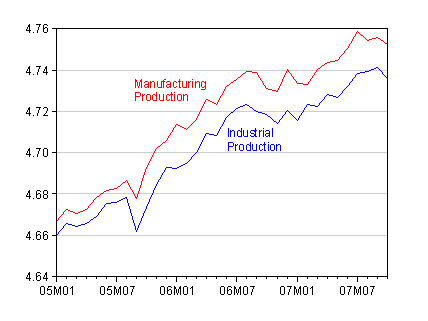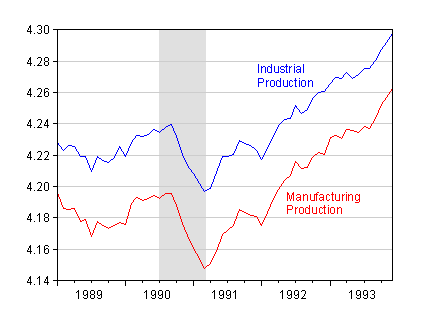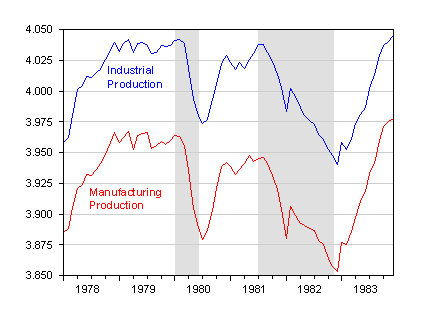And what would it mean if it had?
Over a year ago, I argued that Brad Delong was correct in asserting we wouldn’t know if we were in a recession until we were well into one. I also mentioned that I didn’t think we were in a recession at the time, largely because industrial production was still rising, and had not seemingly peaked as of August 2006.
That characterization no longer holds true. Figure 1 shows industrial production (blue) and manufacturing production (red) indices, in logs.

Figure 1: Log industrial production (blue) and manufacturing production [SIC classification] (red), seasonally adjusted, 2002=100. NBER-defined recessions shaded gray. Source: Federal Reserve Board and NBER.
Originally, I was reassured by the experience during the last recession. In the March 2001-November 2001 recession, production (using the most recent vintage of industrial production series — see this post regarding revised and real time data) peaked some 9 months or so before the onset of the recession.

Figure 2: Log industrial production (blue) and manufacturing production [SIC classification] (red), seasonally adjusted, 2002=100. NBER-defined recessions shaded gray. Source: Federal Reserve Board and NBER.
Unfortunately, this characterization does not hold for the July 1990-March 1991 recession.

Figure 3: Log industrial production (blue) and manufacturing production [SIC classification] (red), seasonally adjusted, 2002=100. NBER-defined recessions shaded gray. Source: Federal Reserve Board and NBER.
In this case, industrial production kept on rising into the recessions. The back-to-back recessions of 1980 and 1981-82 also show roughly contemporaneous peaking of industrial (albeit not manufacturing) production and the onset of recession.

Figure 4: Log industrial production (blue) and manufacturing production [SIC classification] (red), seasonally adjusted, 2002=100. NBER-defined recessions shaded gray. Source: Federal Reserve Board and NBER.
Of course, each recession is different. That’s why the NBER Recession Dating Committee uses a variety of indicators to define a widespread decline in economic activity. To recap from my August 2006 post, the four series cited by the NBER in their decision about the previous business-cycle peak were revised as follows:
- Real personal income less transfers.
- Nonfarm payroll employment.
- Industrial production.
- Manufacturing and trade sales.
In addition, monthly GDP is referred to, although not as a primary indicator.
The oft-mentioned surge in exports might be an important factor in the divergence in industrial production and economic activity as measured along different dimensions. This point is mentioned in this RealTime Economics blog post.
December 3, 2007, 11:23 am
No Recession Yet – in Manufacturing
The latest report on manufacturing from the Institute for Supply Management shows manufacturing activity remains well above recessionary levels.
Norbert Ore, a Georgia-Pacific executive who oversees the ISM survey, cautions that current recession fears — the credit crunch, subprime-mortgage meltdown, and housing market distress — have less to do with manufacturing and more to do with the services industry.
“Most of the industries really impacted would come under our non-manufacturing survey more than our manufacturing survey,” he said, “and there we haven’t seen any deterioration,” he said.
The ISM manufacturing index stood at 50.8 in November compared with 50.9 in October. A reading above 50 indicates expansion.
The November nonmanufacturing report will be released on Wednesday. It stood at 55.8 in October.
But Global Insight’s Nigel Gault says, “The ISM index shows manufacturing keeping its head above water — just — thanks to very strong export orders. But order backlogs are declining and we do not believe that export growth alone can prevent an overall decline in manufacturing output in the current quarter.” –Kelly Evans
That’s why the behavior of the other variables will be closely watched by the committee (keeping in mind the fact that all these series get revised).
For those who can’t wait for the Committee‘s conclusions, we are fortunate that Jim has his statistical model for identifying business cycle turning points.
Technorati Tags: industrial production,
manufacturing, recession,
exports,
But as Services continue to displace manufacturing in the economy, doesn’t Industrial Production matter less and less?
The ISM Manufacturing Index has been weak for some time. But the ISM Services continues to be robust.
Herbert’s recent NYT column reminds me that some Industrial Production is part of The War Effort, which we know is interminable…thus making ‘things different’ now…including the occurrence of recessions wrt peak Industrial Production.
I suppose it is impossible to construct an ex-military Industrial Production but it does seem to me that this destructive activity can extend the Industrial Production figures esp in the event of other components of Industrial Production declining.
GK: What precisely IS the service economy? And is it possible to have all services and no industrial production? And if so why does everyone seem to care so much about how the sinking dollar is good for our exports (presumedly mostly industial)? I harbor great doubts about the so called service economy being an actual economic model – but then I’m no economist.
Nice contrast of the ’01 and earlier recessions, Professor.
I think your caution about current economic conditions is warranted.
Hard to believe that the NBER Business Cycle Dating Committee places real credence in the payroll figures, given the big birth-death adjustments which will be wrong at this inflection point.
To me, it reads and feels like a recession, now: falling real disposable personal income; falling real personal consumption expenditures; falling residential and commercial construction.
I feel for folks who are not aware that change is here. I have adjusted my behavior and outlook. I feel for folks who have not, and who do not have the financial reserves to cushion them if they are wrong.
And: falling corporate profits and falling sales tax collections.
I, honestly, cannot remember any positive data other than exports (which may soften in the future given the sudden cooling in Europe and Japan).
> And is it possible to have all services and no
> industrial production?
Most of the dollars in the productive cycle go to design and sales. Just 16% go to manufacturing.
If that (that number is years old). And there are plenty of states in the union — mostly the prosperous ones — that are even more service-oriented than that.
Thanks, Fred – that’s very interesting. I’m not sure I buy it but it is interesting. Sooo that basically means that in a certain sense 16% of the economic activities can support the other 84%? By support I mean create enough globally tradeable value that the other 84% – which would, by definition, be overhead – can just telecommute our way to economic security? Maybe so but I still think it has more to do with us being able to basically use counterfeit dollars to create our own reality. I guess we’ll see.
Footwedge,
I’m not sure you want to insist that goods and the industries that produce them are the real stuff, everything else overhead. In the goods sector, that may be true. I would not want, for instance, to claim that movie projectors are what we consumers are really after when we buy movie tickets, or that CD are the thing that satisfies us, rather than the music recorded on them. There is real value in services. That is why people pay for them.
Footwedge-
I have heard the claim that we are headed to a service economy for decades, and was skeptical until about the last five years. At one time, half of the population was involved in agriculture. I think it is less than 2% today. The same thing has happened to manufacturing in the US – stable output, declining employment. The productivity increases release workers to do other things, which has meant services.
Even things are generally not desired for themselves, but what they can do for us. A car provides transportation services – you could take a taxi or bus.
jg: The NBER business cycle dating committee makes their decision long after the perceived beginning of the recession, so they are looking at long-revised payroll employment data; see this post for discussion of how many months the peak in payroll employment shifted after the many revisions.
General point of information: Value added in manufacturing in 1987 was 17.1% of GDP, and 12.1% in 2006. However, relative prices have changed (manufacturing prices have declined), so it’s useful to look at chain-weighted real value indices (Source: BEA industry data. There, GDP has increased by 76%, while manufacturing output has increased by 82%.
[Sorry — I posted this comment last night, but my comment “disappeared”]
Thanks to all – this is really excellent stuff. It’s a great pleasure to be exposed to such complex information by very smart guys but portrayed in such a way that a non-economist can mostly grasp it. It is not my intent to be obstinate about this service economy issue and I really want to believe it but I just have these nagging doubts. Here’s my theory: 1) we are in a global economy, right wrong or indifferent; 2)the intn’l marketplace is/will set value on activities, 3) measuring GDP within a given country without using the corresponding value from that market place makes very little sense to me. e.g. I’m in the healthcare industry. Currently it is in excess of 10% of entire GDP by expenditure. Under current calculation it could grow 20% a year driving up nominal GDP while actully contributing nothing of “value” in the int’l market place. I do not dispute the fact that it has and will continue to grow just that it is overpriced in the formula. Obviously we can’t outsource it (although many companies are starting to use offshore facilities) but eventually one would think that non-value adding activities would be encounter wage declines. I can think of a lot of examples of products and services that we consider an important part of our GDP – home building, gov’t services, financial planners, mortgage broker – but which, in the long run, are just “nice” things we Americans (and other developed countries) do for ourselves. Applying Occam’s Razor this would be a pretty simple explanation for huge trade and current account deficit and ongoing wage stagnation in the US. Just a thought.
Thanks, Professor, for the pointer to the reexamination of the ’01 recession starting date. Very informative posting.